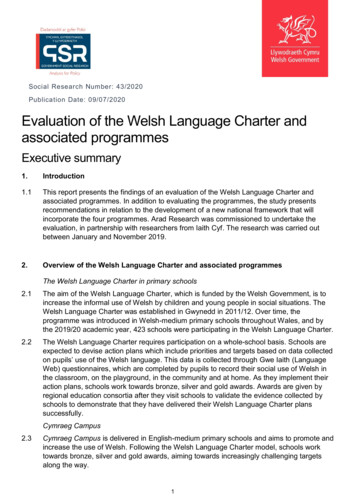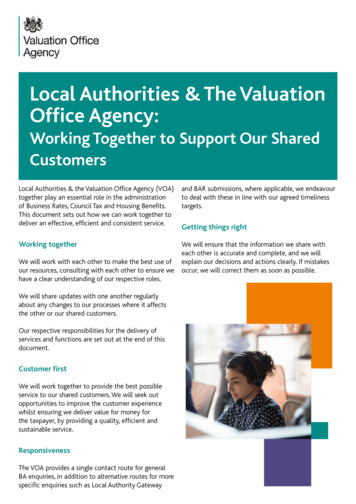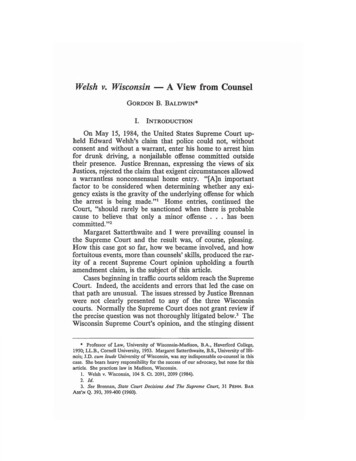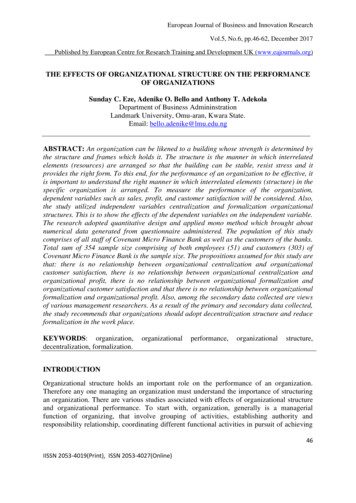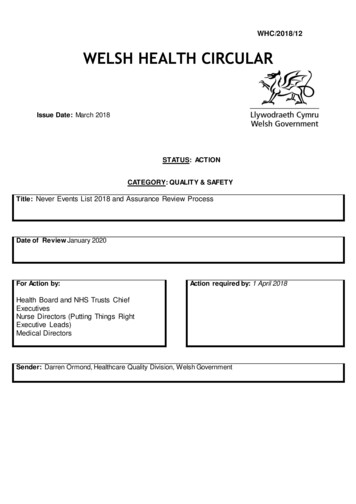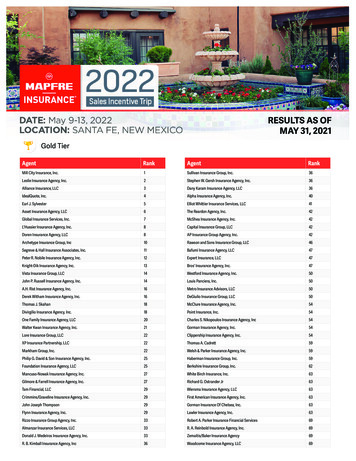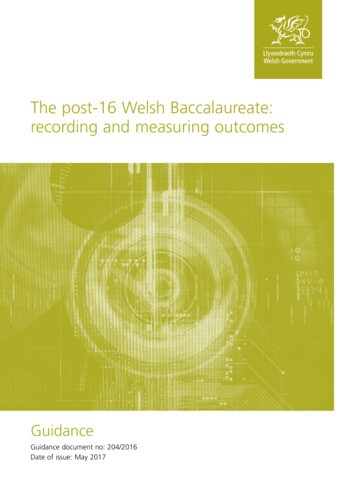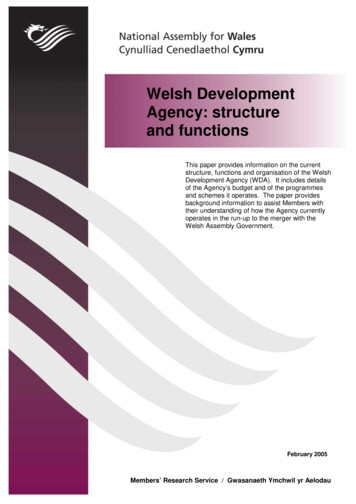
Transcription
Welsh DevelopmentAgency: structureand functionsThis paper provides information on the currentstructure, functions and organisation of the WelshDevelopment Agency (WDA). It includes detailsof the Agency’s budget and of the programmesand schemes it operates. The paper providesbackground information to assist Members withtheir understanding of how the Agency currentlyoperates in the run-up to the merger with theWelsh Assembly Government.February 2005Members’ Research Service / Gwasanaeth Ymchwil yr Aelodau
Members’ Research Service: Research PaperGwasanaeth Ymchwil yr Aelodau: Papur YmchwilWelsh Development Agency:structure and functionsGraham WinterFebruary 2005Paper number: 04/2878/gw Crown copyright 2005Enquiry no: 04/2878/gwDate: 28 February 2005This document has been prepared by the Members’ Research Service to provide Assembly Members and their staff withinformation and for no other purpose. Every effort has been made to ensure that the information is accurate, however, wecannot be held responsible for any inaccuracies found later in the original source material, provided that the original sourceis not the Members’ Research Service itself. This document does not constitute an expression of opinion by the NationalAssembly, the Welsh Assembly Government or any other of the Assembly’s constituent parts or connected bodies.
Members’ Research Service: Research PaperGwasanaeth Ymchwil yr Aelodau: Papur YmchwilContents1Introduction . 12Legal framework. 3.6.43.6.53.73.83.93.103.11Current structure and programmes . 4Land Development and Legal Services . 6Strategy Development. 7Business Support Directorate . 9Business Eye . 9Enterprise Support . 10Technology and Innovation (T&I) group . 11Media and Technology Group . 13Food Directorate. 14Regions . 16North Wales . 17Mid Wales. 17South West Wales . 18South East Wales . 19International Directorate . 21International Services . 21Finance and Development . 21Strategic Accounts Directors . 22Overseas . 22Marketing Division . 24Sector Marketing . 24Technium Marketing Team . 26Regional marketing . 26Marketing Communications . 27Public Relations . 27Finance Wales . 28Support for Communities and Individuals. 30Human Resources directorate. 31Finance. 31Running Costs. 3144.14.2Relationship with the Welsh Assembly Government . 32Guidance and Priorities Letter for 2005-06. 32Reports to Economic Development and Transport Committee . 325Business Plan 2004-2007 . 336Budget. 357Other sources of information . 37Annex A .Welsh Development Agency Guidance and Priorities letter 2005-2006Annex B . Alphabetical list of WDA programmes and initiativesEnquiry no: 04/2878/gwDate: 28 February 2005This document has been prepared by the Members’ Research Service to provide Assembly Members and their staff withinformation and for no other purpose. Every effort has been made to ensure that the information is accurate, however, wecannot be held responsible for any inaccuracies found later in the original source material, provided that the original sourceis not the Members’ Research Service itself. This document does not constitute an expression of opinion by the NationalAssembly, the Welsh Assembly Government or any other of the Assembly’s constituent parts or connected bodies.
Members’ Research Service: Research PaperGwasanaeth Ymchwil yr Aelodau: Papur YmchwilWelsh Development Agency: structure and functions1 IntroductionThe Welsh Development Agency (the WDA or the ‘Agency’) was established by the1Welsh Development Agency Act 1975 . The Agency replaced the Welsh IndustrialEstates Corporation, which had become the responsibility of the Welsh Office, along withthe Department of Industry's regional office for Wales, in 1974-1975. The Act alsoestablished a Welsh Industrial Development Advisory Board. The Development of RuralWales Act 1976 established the Development Board for Rural Wales, with similarfunctions. The WDA merged in 1998 with the Development Board for Rural Wales andthe Land Authority for Wales.Since devolution in 1999, the WDA is accountable to the National Assembly for Wales.However, the power to allocate government loans to the Agency remains shared betweenthe Assembly and the UK Government.The WDA is the “Economic Development Agency for Wales, working for its people,2creating prosperous communities by helping businesses to start, develop and grow.” .On the 14 July 2004, the First Minister announced that the WDA, as well as the WalesTourist Board (WTB) and the National Council for Education and Training (ELWa) wouldcease to be Assembly Sponsored Public Bodies (ASPBs) and that their work would betransferred into the administration of the Welsh Assembly Government (WAG) by 1 April32006 .2 Legal frameworkThe Welsh Development Agency Act 1975 established both the Agency and the Welsh4Industrial Development Advisory Board . The Act has been amended by subsequentlegislation including the Government of Wales Act 1998 that established the Assemblyand the Transfer of Functions Order 1999 (SI1999/672), which transferred most of theresponsibilities for the Agency from the Secretary of State to the Assembly.Sections 2 and 3 of the 1975 Act, as amended, set out the purpose of the Agency asfollows:“The purposes for which the Agency may exercise their functions are—(a) to further the economic and social development of Wales or any part of Wales,and in that connection to provide, maintain or safeguard employment;(b) to promote efficiency in business and international competitiveness in Wales;1Wales Legislation Online, dex.html2Welsh Development Agency internet page, at:http://www.wda.co.uk3For more information see the MRS Research Paper The Reform of Assembly Sponsored Public Bodies, September .pdf4Board that advises the Minister for Economic Development & Transport on applications for Regional Selective Assistance1
Members’ Research Service: Research PaperGwasanaeth Ymchwil yr Aelodau: Papur Ymchwil(c) to further the improvement of the environment in Wales having regard toexisting amenity.Without prejudice to the following provisions of this Act, the functions of the Agencyshall be—(a) to promote Wales as a location for businesses, or assist or concert itspromotion as such a location;(b) to provide finance for persons carrying on or intending to carry on businesses;(c) to carry on industrial undertakings and to establish and carry on newbusinesses;(d) otherwise to promote or assist the establishment, growth, modernisation ordevelopment of businesses, or a particular business or particular businesses;(e) to make land available for development;(f) to provide sites, premises, services and facilities for businesses;(g) to manage sites and premises for businesses;(h) to bring derelict land into use or improve its appearance;(i) to undertake the development and redevelopment of the environment;(j) to promote the private ownership of interests in businesses by the disposal ofsecurities and other property held by the Agency or any of their subsidiaries.”Some of the other most important sections of the 1975 Act are briefly described below:Section 2 of the 1975 Act sets out the constitution and status of the Agency. This statesthat the chairman, deputy chairman and other members of the Agency (of which theremust be between seven and nine) shall be appointed by the National Assembly for Wales(the Secretary of State prior to 1999).Section 5 allows the Agency to appoint a local authority to carry out functions on itsbehalf.Section 9 provides powers to the Agency in relation to the provision of sites and premises.Section 13 established the Welsh Industrial Development Advisory Board.Section 16 deals with derelict land and was introduced into the act by the Derelict LandAct 1982.Section 18 deals with finances of the Agency and sets a limit on the cumulative fundingprovided by Government and the aggregate amount of outstanding borrowing that theAgency may have. The Welsh Development Agency Act 1997 introduced the provisionfor this amount to be varied by order and set the limit at 1,350 million. This wassubsequently increased by order to 2 billion.2
Members’ Research Service: Research PaperGwasanaeth Ymchwil yr Aelodau: Papur YmchwilThe Welsh Development Agency (Financial Limit) Order 2004 approved by the Assemblyon 14 July 2004, further increased the limit to 3 billion.Sections 21A, 21B and 21C deal with land acquisition, land disposal and the provision ofadvice on land matters. The Government of Wales Act 1998 inserted these sections.3
Members’ Research Service: Research PaperGwasanaeth Ymchwil yr Aelodau: Papur Ymchwil3 Current structure and programmesThe WDA is organised into the following Divisions, which are supported by the HeadOffice (Plas Glyndwr), based in Cardiff, where the Chairman’s and Chief Executive’sOffice are located.The pan WDA Divisions with offices and staff in Cardiff and each of the regions are: Land Development & Legal Services DivisionBusiness Support DivisionInternational Division (also with offices overseas)Strategy DevelopmentMarketing DivisionFinanceHuman ResourcesFinance Wales (based in Oakleigh House)The four Regional Divisions are located at the following locations in Wales: North Wales (St. Asaph)South East Wales (Treforest)Mid Wales (Newtown and Aberystwyth)South West Wales (Swansea)The overall strategic direction and policy of the WDA is subject to the approval of itsBoard. This comprises the Chairman, thirteen non-executive members and the ChiefExecutive.The Executive Directors of the WDA oversee the planning and implementation of thenormal business activities of the WDA, supported throughout by teams of staff.During 2003 and 2004, the WDA carried out an internal review (review of Organisation,Development and Design) of its structure. One outcome of this review was a plan tochange the regional structure of the Agency to one that would give more emphasis toprogrammes. However following the First Minister’s merger announcement in July 2004and the subsequent resignation of the Chief Executive, this plan will not now proceed.4
Members’ Research Service: Research PaperGwasanaeth Ymchwil yr Aelodau: Papur YmchwilThe senior staff structure of the Agency is as follows:WDAExecutive Management TeamChief ExecutiveExecutiveDirectorInternationalGroup arketingNorth dDevelopmentand orFinance DirectorExecutiveDirectorMid WalesDivisionSouth EastWales DivisionExecutive DirectorBusiness SupportExecutiveDirectorSouth WestWales DivisionIn February 2005, the approximate number of staff in each part of the Agency was asfollows:Executive Management TeamChairman and Chief Executive’s OfficeHuman ResourcesFinanceLand Development & Legal ServicesStrategy DevelopmentBusiness SupportNorth WalesMid WalesSouth West WalesSouth East WalesInternationalMarketingFinance Wales*1071960693226490647311311446102TOTAL1,063* excluding about 40 consultants employed on programmesThese staff numbers relate to business functions, rather than the locations where staff arebased. For example, a number of the Business Support and Marketing staff are based inthe regions, but are not included in the regional figures given in the table above.Further information about each Division, including the programmes and activities forwhich they are responsible is set out below.5
Members’ Research Service: Research PaperGwasanaeth Ymchwil yr Aelodau: Papur Ymchwil3.1Land Development and Legal ServicesThe Land Development and Legal Services Division has a team based in Cardiff and ateam based in St. Asaph. There is also a Resources Team and a Legal Team in Cardiff.The Division employs 69 staff and in 2004-05, the budget for the Division was 30 million,although the Division is expected to be self-financing.The role of the Division is as follows:“The WDA Land Development and Legal Services Division is a highly experiencedteam of specialists within the Welsh Development Agency whose primary task is toidentify and acquire such land and to make it available to developersOur team contains a full spectrum of professional expertise enabling it to overcomeany legal or physical hurdles preventing an investment from going ahead.In doing this, the Division works in partnership with the private sector, and the publicand voluntary sectors, including local authorities and housing associations.We also bring major benefits to local communities. Over the years our work haspaved the way for investments of more than 1 billion, creating several thousandnew jobs and enhancing the lives of communities right across Wales. Projectsrange from a single plot of land, acquired for a local authority to create a park, to amulti-owner derelict city centre site, assembled and delivered to developers wishingto create a major shopping complex. Our investment in infrastructure ranges fromsmall access roads to a 15 million dual carriageway.The WDA Land Development and Legal Services team is unique within the WDAbecause we are obliged to self-fund our activities each year. This means we mustthink and act commercially while, at the same time, ensuring that we protect thewider interests of the people of Wales. Any surplus achieved from our landtransactions is used to buy further land for development and to cross-subsidiseprojects in regions of Wales which currently find it hard to attract new investment.The Division is also unique in the UK because it has powers, unmatched elsewhere,5to sweep away legal and bureaucratic barriers to new development.”The Division is responsible for Pan-Wales Land Services6.The Division is also responsible for the preparation of annual Housing Land AvailabilityStudies for each of the Unitary Authorities in Wales, as authorities are required by theWelsh Assembly Government to have a minimum five year supply of housing land on arolling basis.5http://www.wda.co.uk/index.cfm/property advice and support/the land division of the welsh development y advice and support/wda properties/land pan wales services/en26506
Members’ Research Service: Research PaperGwasanaeth Ymchwil yr Aelodau: Papur Ymchwil3.2Strategy DevelopmentStrategy Development Division works across the Agency to provide an ‘all Wales’strategic focus, and holds responsibility for Sustainable Development initiatives, RuralPolicy, Sector Strategies and the European Unit. The Division employs 32 staff and in2004-05 the budget for Strategic Planning/Strategy Development was 6.3 million.The Division is responsible for the completion of the Corporate Business Plans. It hasresponsibility for monitoring the performance of the Agency and improving performancemeasurement capabilities through the development of appropriate measures, training andskills enhancement in project appraisal, objective setting and project monitoring.Strategy Development also implements a practical research programme to improveunderstanding of Welsh economic issues, carries out impact analysis for the BusinessPlan, informs the development of future policies and initiatives, provides advice, guidanceand information e.g. maintains a database of Agency wide research, regional economicprofiles etc.The Division also develops innovative approaches to project delivery, most notably in the7St.Athan DARA project , which is a proactive cross-Agency approach.Strategy Development also has responsibility for Sustainable Development issues acrossthe Agency and leads on the Agency’s approach ‘Learning to Work Differently’.The European Unit supports colleagues throughout the Agency as well as being the firstpoint of contact for external stakeholders. Its remit is Agency wide and its aim is tosupport, advise, interpret and inform planning and implementation relating to EU activitiesas well as providing guidance on claims.The Rural Unit takes the lead on rural policy issues as well as being responsible forfacilitating and managing the implementation of rural programmes throughout Wales,aiming to regenerate and develop the rural communities in Wales. The WDA is one of 278organisations contributing to the Rural Partnership for Wales , an advisory bodyestablished in 1998 in recognition of the economic and social problems of people livingand working in rural Wales.The principal concern of the partnership is the development of policies and programmescapable of delivering substantial benefits to the rural areas of Wales, ensuring that theneeds and aspirations of rural communities are at the fore of the Welsh AssemblyGovernment’s agenda.An example of one of the rural programmes is Leader .LEADER 9 is a European Community Initiative with funding from the EuropeanAgricultural Guarantee and Guidance Fund (EAGGF) and match funding from the WelshAssembly Government.7http://news.mod.uk/news/press/news press notice.asp?newsItem id 2346http://www.wda.co.uk/index.cfm/working with your community/rural recovery plan/en1199http://www.wda.co.uk/index.cfm/working with your community/rural programmes/leader /en588387
Members’ Research Service: Research PaperGwasanaeth Ymchwil yr Aelodau: Papur YmchwilThe aim of the LEADER programme is to pilot innovative approaches to ruraldevelopment which will contribute to a more sustainable society, economy andenvironment for Rural Wales.The objectives are to test new approaches to rural development; to build the capacity oftarget groups, communities and businesses and encourage their involvement; to securethe sustainability of successful pilot projects by integrating into mainstream programmesand transferring the approach to new areas; and to learn from other rural areas andsupport in joint activities where appropriate.1011Under Article 33 of the Rural Development Plan for Wales provisions have been madefor measures to promote the adaptation and development of rural areas.The measures relate to: Basic services for the rural economy and population;Renovation and development of villages and protection and conservation of therural heritage; andEncouragement for tourist and craft activitiesFunding is provided by the Welsh Assembly Government for projects identified in ActionPlans submitted by the five eligible Community Partnerships in Flintshire, Wrexham,Powys, Monmouthshire and Vale of Glamorgan.12Rural Community Action has been developed to address one of the Welsh AssemblyGovernment’s main priorities to develop communities where people want to live, work andvisit and where there is access to economic opportunity and reward, a pleasant and safeenvironment and active and social community networks.Funding has been provided by the Welsh Assembly Government to set up RuralCommunity Action Partnerships to promote rural community regeneration.The main purpose of the programme is to develop the capacity of the communities and toidentify projects by providing knowledge and skills to these communities.The Rural Retail programme13 is a Welsh Assembly Government Funded programme thatprovides support measures for rural businesses and communities across Wales.Support is available through advice and grant and is available to businesses that candemonstrate that they are the last remaining village shop, a vital rural retailer, outside atown centre and within a rural ward. Support is available in the first instance through oneand a half days of specialist advice. If eligible, applicants can then apply for a maximumgrant of 5,000.10http://www.wda.co.uk/index.cfm/working with your community/rural programmes/article ster.asp?n1 4&n2 25612http://www.wda.co.uk/index.cfm/working with your community/rural programmes/rural community ing with your community/rural programmes/rural retail/en5886118
Members’ Research Service: Research PaperGwasanaeth Ymchwil yr Aelodau: Papur Ymchwil3.3Business Support DirectorateThe Business Support Directorate is responsible for business support strategy anddelivery of services to support new and existing businesses in Wales, providing support tothe three customer groups of the WDA: businesses, individuals and communities. Suchsupport involves attitude and culture change activities as well as delivery of general andspecialist help to start, sustain, develop and grow Welsh businesses. The Divisionemploys 264 staff, including some that are based in the regions.14The 2004-05 budgets for the services led by the Division were :Support for BusinessInnovation & TechnologyInformation SocietyFood 32.1 million 39 million 7.5 million 22.7 millionCore services for businesses include: information and signposting, support for networksand sector fora, general support for both new and existing businesses specialist sectorand/or subject specific support, financial support and help with supply sourcing.The regional offices undertake much of the delivery of Business Support services.Specifically below are details of five business areas with some examples of programmes:Business Eye, enterprise support, technology and innovation, media technologyprogrammes and food. There is also a support services team.3.3.1Business EyeBusiness Eye15 is available across Wales through a low-cost telephone number.Telephone and internet enquiry responses are managed through a single contact centreat Morganstown. The centre is staffed by about 10 Business Information Officers. OtherBusiness Eye staff are based in Cardiff, with 3 staff in North Wales.There is also a network of local centres where clients can meet with staff face-to-face.These centres are delivered through contract with external organisations, including manylocal authorities. Local Business Eye offices are located in:North WalesAnglesey, Caernarfon, Llandudno Junction, Mold, Pwllheli, Rhyl, Ruthin, WrexhamMid WalesAberystwyth, Brecon, Cardigan, Dolgellau, Lampeter, Llandrindod Wells,Penrhydeudraeth, Welshpool, YstradgynlaisSouth West WalesCarmarthenshire, Swansea Bay, Pembrokeshire1415There is also a budget of 11.9 million for Participation under the Support for Individuals heading.http://www.businesseye.org.uk/9
Members’ Research Service: Research PaperGwasanaeth Ymchwil yr Aelodau: Papur YmchwilSouth East WalesBlaenau Gwent, Bridgend, Caerphilly, Cardiff, Merthyr Tydfil, Newport,Monmouthshire, Rhondda Cynon Taf, Torfaen, Vale of GlamorganFurther information is provided in a Business Eye progress report to the Business16Partnership Council in June 2004 .In addition, the Division operates a General Business Advisory Service (GBAS) andDiagnostic and Specialist Consultancy Services. The aim of the GBAS, which is fundedthrough Objective 1, is “to deliver consistent and quality general support includingdiagnosis and advice to SME’s throughout Wales to ensure their sustainability and17growth.”3.3.2Enterprise Support SME Equality Project. Supported by the European Social Fund and providessupport to Small and Medium sized businesses in developing good practice in equalopportunities. The Development Employability Equality Partnership (DEEP), comprising of 27organisations and led by the WDA to highlight good practice with a view toinfluencing policy at a Regional, National and European level on the discriminationwhich effects excluded groups of people when entering / re entering the workplace. Following research and public consultation, the Entrepreneurship Action Plan (EAP)18for Wales strategy document , The Sky is the Limit , was published in March 2000.This document sets out a framework for promoting, encouraging and developingentrepreneurship throughout Wales. After further consultation, the EAPimplementation plan, Making it Happen, was published in September 2000. The19Implementation Plan details the delivery mechanisms, partnerships, costs andtargets associated with each of the 6 Key Actions contained in the StrategyDocument. 20Because You Can is a website aimed at encouraging people in Wales to start abusiness or to grow an existing business. The Dynamo programme is designed to encourage young people to think positivelyand to have the confidence to act in creative and enterprising ways. Local businessowners enter school classrooms across Wales to inspire young people with theirpersonal experiences of launching and running businesses. 21Taste of Enterprise offers opportunities for young people studying or inemployment and unemployed people of all ages to test trade their business ideas ina safe environment and without having to forego income of benefits. /ent actionplan da.co.uk/index.cfm/wda home/ busnes the wda e zine/ busnes issue 3/feature the spirit of enterprise/en161410
Members’ Research Service: Research PaperGwasanaeth Ymchwil yr Aelodau: Papur Ymchwilprogramme includes three projects; The Enterprise Factory, The EnterpriseRehearsal Programme and The Market Place. 22The procurement website Sell2Wales helps small and medium sized businessesin Wales compete for public sector contracts which are worth up to 3 billion a year. The Cyfenter Development Partnership is jointly funded by WDA and the Equalprogramme of European funding - a European Social Fund initiative which tests andpromotes new means of combating all forms of discrimination and inequalities in thelabour market through transnational co-operation. The key objective of Cyfenter isto deliver an innovative action based research programme working directly withunder represented groups in enterprise (women, lone parents, young people, over50’s, ethnic minorities, refugees, disabled people and Welsh speakers) to identifytheir needs when establishing a business; identify barriers to their success; and towork with policy makers to deliver solutions which meet those needs and removeexisting barriers. Potentia is a pre business start programme funded through Objective 1 to supportyoung people, the over 50s, disabled people, black and minority ethnic groups,Welsh speakers and lone parents. The Division is also developing a High Growth Starts Programme that wasscheduled to start in November 2004. This replaces the former Business Birth RateStrategy.3.3.323Technology and Innovation (T&I) groupThe role of the Technology and Innovation
Agency: structure and functions This paper provides information on the current structure, functions and organisation of the Welsh Development Agency (WDA). It includes details of the Agency's budget and of the programmes and schemes it operates. The paper provides background information to assist Members with their understanding of how the .
